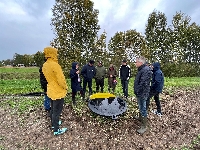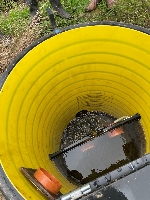On Thursday, 12 October, Institute for Environmental Solutions (IES) organized an open-door day on controlled drainage (CD). Representatives from various sectors - farmers, agronomists, agricultural consultants, land reclamation specialists - were presented with insights into the effectiveness of controlled drainage in both agricultural and climate contexts.
The event took place in Smiltene, in the "Rožkalni" field, which serves as one of the pilot areas for controlled drainage. The event took place in Smiltene, in the "Rožkalni" field, which serves as one of the pilot areas for controlled drainage. During the open-door day, researcher at the Institute for Environmental Solutions and coordinator of LIFE CRAFT project Rūta Abaja introduced with the principles of the controlled drainage, demonstrated two field checkpoints, a field weather station and presented findings from research on the effectiveness of this method. Gatis Pētersons, agronomist of Z/S "Rožkalni", gave an insight into the yield indicators and other valuable observations of the pilot area, while Dainuvīte Roginska, communication specialist of the Latvian Fund for Nature, briefly presented the LIFE CRAFT project and the 3 climate-friendly farming methods discussed there.
Monitoring data from the LIFE CRAFT project confirms that CD helps retain water in the soil. This was more observed when comparing the dry periods in the CD fields before water level regulation and during CD regulation at maximum water retention.
In the CD fields groundwater level dropped about twice as slowly as in equivalent duration drought periods in these fields before the establishment and regulation of the CD system. The height of the retained water level during the dry period was on average 15-30 cm higher than during a similar dry period without the application of CD regulations.
It should be noted that it was difficult to make comparisons across areas, because most of the comparison fields initially had unequal groundwater levels prior to the establishment of the CD, which evidently was due to the different micro-relief and soil characteristics of the field or parts of it.
The results of the CO2 measurements obtained during the project are ambiguous. Practically all the reference pilot areas in the project, already have higher CO2 emissions during the growing season, before any significant CD regulations. In 2023 it was expected, that the total of CO2 emissions in CD fields will decrease or at least be comparable or lower in contrast what CO2 emissions were observed in the reference fields, however no such conclusive results were obtained.
The best and closer to the expected results were achieved in one of the CD fields in Meņģele (the second LIFE CRAFT pilot area where the CD method was tested) and Smiltene, where the water level was retained the most.
At the end of the summer, when the highest CO2 emissions in season appears in the data, the difference between the reference and CD fields has levelled off or even lower in the CD fields. These observations partly suggest that at a sufficiently significant rise in water level in CD fields, it is possible to reduce CO2 emissions with the help of CD.
It should also be noted that these tendencies were observed in late summer 2023, when there was virtually no significant precipitation for almost three months, so the differences in CO2 values were observed at a time when the impact of CD are most pronounced. The amount of N2O and CH4 emission removal changes in CD field was insignificant.
Regarding the impact of CD on yield, agronomist at Z/S "Rožkalni" Gatis Pētersons says that, although harvests are certainly affected by various factors, the field with the CD system has produced the highest yields this year. On average, the farm has produced 5 tons of rye per hectare this year, but this field has yielded 7,5 tons per hectare. The agronomist also adds that the farm's ploughman, when tilling the field after harvest, found it to be noticeably wetter than the others.




